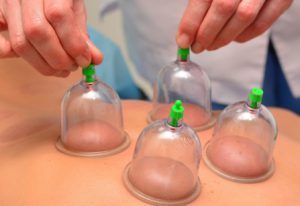 Anyone who watched the Olympics this summer couldn’t help but notice the large, circular marks on the bodies of many of the competitors. These are the result of cupping therapy, a growing trend among athletes and celebrities.
Anyone who watched the Olympics this summer couldn’t help but notice the large, circular marks on the bodies of many of the competitors. These are the result of cupping therapy, a growing trend among athletes and celebrities.
While gaining a great deal of attention recently, the practice of cupping actually dates back to ancient Egyptian, Chinese and Middle Eastern cultures where it is believed to help with pain, blood flow, and relaxation.
How does cupping work? First, it’s important to know that there are two different types of cupping.
Dry cupping is one type of therapy that involves a therapist placing special cups on the patient for a few minutes to create a suction sensation. The suction is created by placing a flammable substance inside the cups to start a fire. Once the fire inside the cup is extinguished, they are placed upside down on the patient’s skin. As the air inside the cups cools, it creates a vacuum which causes the skin under the cup to rise and redden as the blood vessels expand. The suction process takes approximately three minutes.
While dry cupping ends after this process is completed; a second form of cupping, known as wet cupping can take place if desired. During the wet cupping process, the therapist will make light cuts in the skin with a scalpel after the cups are removed, then reapply the cups to draw a small quantity of blood (and presumed toxins) out of the body. After the cups are removed the second time, ointments and bandages are applied to prevent infection.
Those who practice cupping as a form of therapy usually get anywhere from three to seven cups applied per session.
While there is very little research to prove the effectiveness of cupping, some studies have stated that it could be used to help with the management of pain and assist with conditions such as acne, herpes zoster and cervical spondylosis.
Cupping is considered safe is performed by a qualified therapist, but it can lead to mild discomfort and in some cases, it can cause burns, bruises, or skin infections. It is recommended that you speak to your doctor before you start cupping.
All content of this newsletter is intended for general information purposes only and is not intended or implied to be a substitute for professional medical advice, diagnosis or treatment. Please consult a medical professional before adopting any of the suggestions on this page. You must never disregard professional medical advice or delay seeking medical treatment based upon any content of this newsletter. PROMPTLY CONSULT YOUR PHYSICIAN OR CALL 911 IF YOU BELIEVE YOU HAVE A MEDICAL EMERGENCY.
